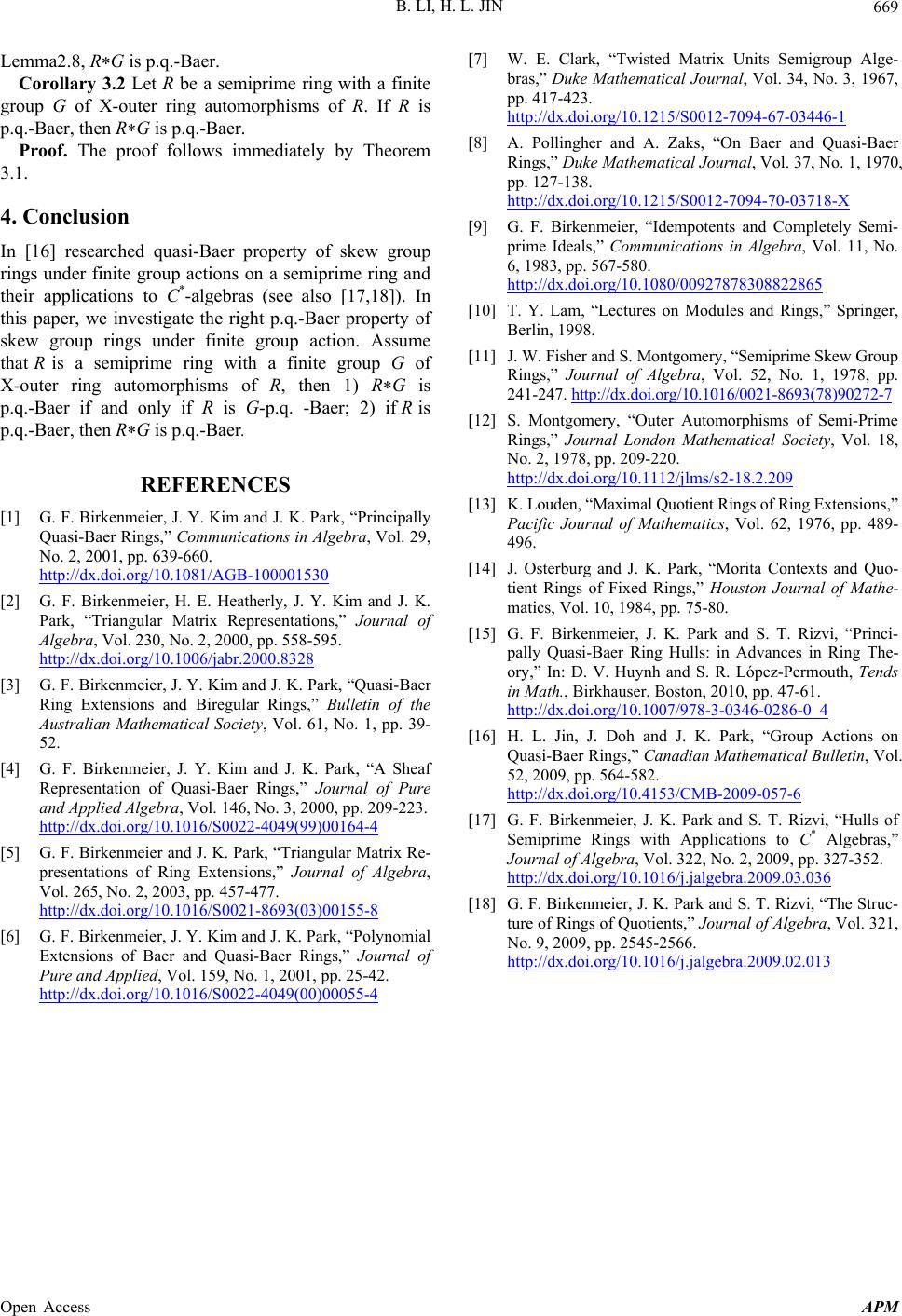
B. LI, H. L. JIN
Open Access APM
669
[7] W. E. Clark, “Twisted Matrix Units Semigroup Alge-
bras,” Duke Mathematical Journal, Vol. 34, No. 3, 1967,
pp. 417-423.
http://dx.doi.org/10.1215/S0012-7094-67-03446-1
Lemma2.8, R*G is p.q.-Baer.
Corollary 3.2 Let R be a semiprime ring with a finite
group G of X-outer ring automorphisms of R. If R is
p.q.-Baer, then R*G is p.q.-Baer. [8] A. Pollingher and A. Zaks, “On Baer and Quasi-Baer
Rings,” Duke Mathematical Journal, Vol. 37, No. 1, 1970,
pp. 127-138.
http://dx.doi.org/10.1215/S0012-7094-70-03718-X
Proof. The proof follows immediately by Theorem
3.1.
4. Conclusion [9] G. F. Birkenmeier, “Idempotents and Completely Semi-
prime Ideals,” Communications in Algebra, Vol. 11, No.
6, 1983, pp. 567-580.
http://dx.doi.org/10.1080/00927878308822865
In [16] researched quasi-Baer property of skew group
rings under finite group actions on a semiprime ring and
their applications to C*-algebras (see also [17,18]). In
this paper, we investigate the right p.q.-Baer property of
skew group rings under finite group action. Assume
that is a semiprime ring with a finite group G of
X-outer ring automorphisms of R, then 1) R*G is
p.q.-Baer if and only if R is G-p.q. -Baer; 2) ifis
p.q.-Baer, then R*G is p.q.-Baer.
R
R
[10] T. Y. Lam, “Lectures on Modules and Rings,” Springer,
Berlin, 1998.
[11] J. W. Fisher and S. Montgomery, “Semiprime Skew Group
Rings,” Journal of Algebra, Vol. 52, No. 1, 1978, pp.
241-247. http://dx.doi.org/10.1016/0021-8693(78)9027 2-7
[12] S. Montgomery, “Outer Automorphisms of Semi-Prime
Rings,” Journal London Mathematical Society, Vol. 18,
No. 2, 1978, pp. 209-220.
http://dx.doi.org/10.1112/jlms/s2-18.2.209
REFERENCES [13] K. Louden, “Maximal Quotient Rings of Ring Extensions,”
Pacific Journal of Mathematics, Vol. 62, 1976, pp. 489-
496.
[1] G. F. Birkenmeier, J. Y. Kim and J. K. Park, “Principally
Quasi-Baer Rings,” Communications in Algebra, Vol. 29,
No. 2, 2001, pp. 639-660.
http://dx.doi.org/10.1081/AGB-100001530 [14] J. Osterburg and J. K. Park, “Morita Contexts and Quo-
tient Rings of Fixed Rings,” Houston Journal of Mathe-
matics, Vol. 10, 1984, pp. 75-80.
[2] G. F. Birkenmeier, H. E. Heatherly, J. Y. Kim and J. K.
Park, “Triangular Matrix Representations,” Journal of
Algebra, Vol. 230, No. 2, 2000, pp. 558-595.
http://dx.doi.org/10.1006/jabr.2000.8328
[15] G
. F. Birkenmeier, J. K. Park and S. T. Rizvi, “Princi-
pally Quasi-Baer Ring Hulls: in Advances in Ring The-
ory,” In: D. V. Huynh and S. R. López-Permouth, Tends
in Math., Birkhauser, Boston, 2010, pp. 47-61.
http://dx.doi.org/10.1007/978-3-0346-0286-0_4
[3] G. F. Birkenmeier, J. Y. Kim and J. K. Park, “Quasi-Baer
Ring Extensions and Biregular Rings,” Bulletin of the
Australian Mathematical Society, Vol. 61, No. 1, pp. 39-
52. [16] H. L. Jin, J. Doh and J. K. Park, “Group Actions on
Quasi-Baer Rings,” Canadian Mathematical Bulletin, Vol.
52, 2009, pp. 564-582.
http://dx.doi.org/10.4153/CMB-2009-057-6
[4] G. F. Birkenmeier, J. Y. Kim and J. K. Park, “A Sheaf
Representation of Quasi-Baer Rings,” Journal of Pure
and Applied Algebra, Vol. 146, No. 3, 2000, pp. 209-223.
http://dx.doi.org/10.1016/S0022-4049(99)00164-4 [17] G. F. Birkenmeier, J. K. Park and S. T. Rizvi, “Hulls of
Semiprime Rings with Applications to C* Algebras,”
Journal of Algebra, Vol. 322, No. 2, 2009, pp. 327-352.
http://dx.doi.org/10.1016/j.jalgebra.2009.03.036
[5] G. F. Birkenmeier and J. K. Park, “Triangular Matrix Re-
presentations of Ring Extensions,” Journal of Algebra,
Vol. 265, No. 2, 2003, pp. 457-477.
http://dx.doi.org/10.1016/S0021-8693(03)00155-8 [18] G. F. Birkenmeier, J. K. Park and S. T. Rizvi, “The Struc-
ture of Rings of Quotients,” Journal of Algebra, Vol. 321,
No. 9, 2009, pp. 2545-2566.
http://dx.doi.org/10.1016/j.jalgebra.2009.02.013
[6] G. F. Birkenmeier, J. Y. Kim and J. K. Park, “Polynomial
Extensions of Baer and Quasi-Baer Rings,” Journal of
Pure and Applied, Vol. 159, No. 1, 2001, pp. 25-42.
http://dx.doi.org/10.1016/S0022-4049(00)00055-4